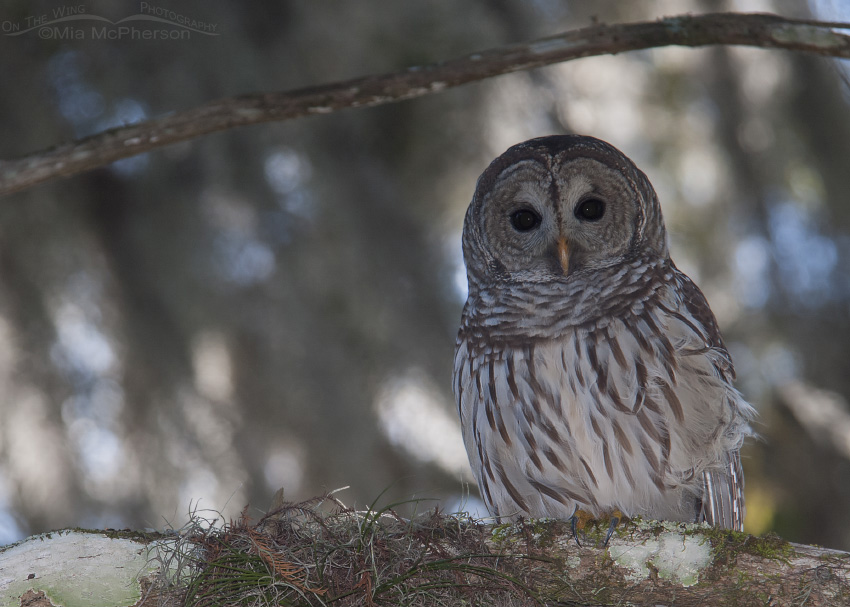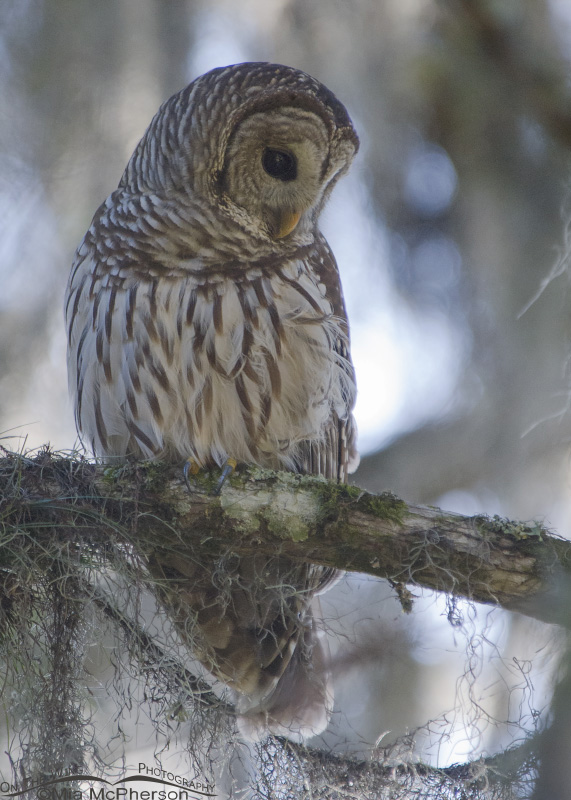 Barred Owl, Spanish Moss and Dappled Light – Nikon D200, handheld, f5.6, 1/160, ISO 200, Nikkor 80-400mm VR at 300mm, flash fired, not baited
Barred Owl, Spanish Moss and Dappled Light – Nikon D200, handheld, f5.6, 1/160, ISO 200, Nikkor 80-400mm VR at 300mm, flash fired, not baited
When I lived in Florida I spent most of my time photographing birds on the coast so I didn’t have many opportunities with Barred Owls and usually when I did see them they were nearly hidden in the understory and hanging Spanish Moss. In October of 2008 I spent a morning with a few of my friends at Lettuce Lake Park in Hillsborough, County Florida and we wandered the boardwalk looking for birds to photograph. The weather was comfortable and the company was great.
 Barred Owl – Nikon D200, handheld, f5.6, 1/250, ISO 640, Nikkor 80-400mm VR at 400mm, flash fired, not baited
Barred Owl – Nikon D200, handheld, f5.6, 1/250, ISO 640, Nikkor 80-400mm VR at 400mm, flash fired, not baited
We found this Barred Owl roosting on a moss covered branch near the Hillsborough River next to the boardwalk. It didn’t open its eyes often and the situation called for the use of fill flash which I really don’t care to use, on owls especially. We were patiently waiting for the times that the owl opened its eyes on its own.
But then another photographer walked up to our small group and started playing the calls of Barred Owls on his phone or an iPod. The guy kept playing the call over and over until the owl became visibly distressed and flew away. That guy robbed us all of more photos of the owl and none of us were pleased.
I never use calls in the field and that is a matter of my own personal ethics because I feel that birds have a hard enough time in the wild without photographers manipulating them by the use of calls or baiting the subject. But there are photographers who will use the calls over and over again to draw the birds closer or to bring them into what I call an outdoor studio that has been set up to provide a perch and backdrop and they do this even during the breeding season.
The calls can bring birds out into the open where they are more visible to predators and they can cause birds on breeding territory to expend their precious energy looking for an invisible rival. The birds need every bit of energy they have to breed, brood and rear their young.
In my opinion the over use of recorded calls is selfish and shows little regard for the living subject.
There is never a time when the image is more important that the safety and well being of the subject.
Ever.
We could have spent more time with this Barred Owl and it may have eventually moved to a better location for us to get photos but because of one person ticking off the owl we didn’t get that chance.
Mia
Click here to see more of my Barred Owl photos.


Oh Mia, this is so distressing. I have rarely used calls and do so only briefly, often just to verify a song. I agree with you that the welfare of the bird is more important than my need to see it or get a photo.That person was so inconsiderate of the bird and others. It was a very selfish act. I wish more people would put wildlife first!
Yes.
It isn’t and it shouldn’t be ‘all about us’. And particularly not about us and our likes and wants taking precedence over other species’ needs.
Loved your owl too.
Great post Mia, and sadly, this happens quite frequently–particulary, it seems, with owls. And I understand why: we all want to get better looks, and a good photo is always nice to take home. In the excitement of the moment, many of us fail to consider the well-being of the animal we’re watching. Several years ago, I was at least partially responsible for spooking a relatively rare bird out of a field. Happily, it came back later, so no permanent harm done, but I felt terrible about it for weeks–not because others were trying to watch it (though I regretted that as well), but because I had stressed the bird and forced it to expend energy that it otherwise could have conserved. In my excitement, I had failed to do the one thing that is paramount: consider the comfort of the bird.
There is a time and a place for photography–it captures the moment, allows you to relive it and share it with others, and a good photo can often spark someone else’s interest and set them on the road to learning more about the subject and, ultimately, caring about its welfare and working to preserve it. But as you point out, and as I have always kept in mind since that incident, the bird comes first. If capturing a photo requires harassing or stressing the subject, then the even the best picture in the world doesn’t justify the lengths taken to get it. We all make mistakes, but with just a little thought and consideration, many of them can be prevented. If you’re paying attention, it’s easy to see when you’ve gone to far and your presence is causing discomfort. Many birds are quite accommodating, but it takes patience, awareness, and a healthy dose of respect for their wild nature. The real issue, to me, is when people don’t care, when they put their needs and desires above the welfare of the bird. I have zero tolerance for that, and though my better nature wants to educate them, I really just want to take their cameras and shove them into what a friend tactfully described as “somewhere dark and not so pleasantly aromatic.”
Thanks for posting this, and reminding us all of what’s truly important, and the balancing act we all have to perform.